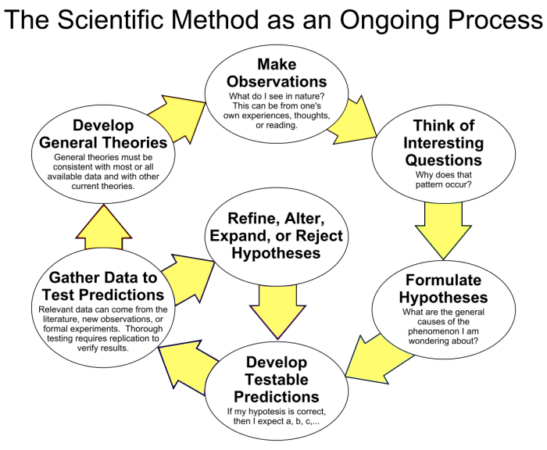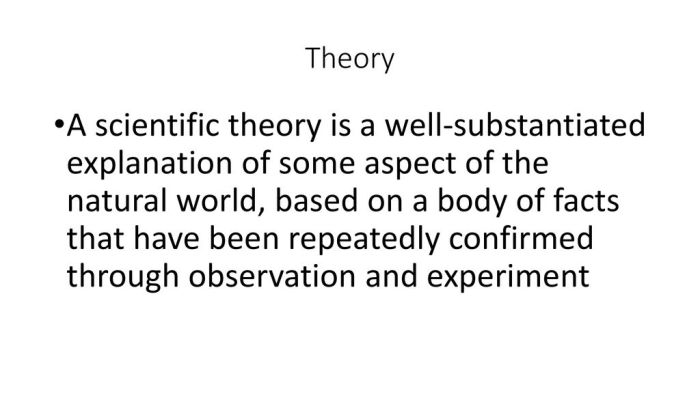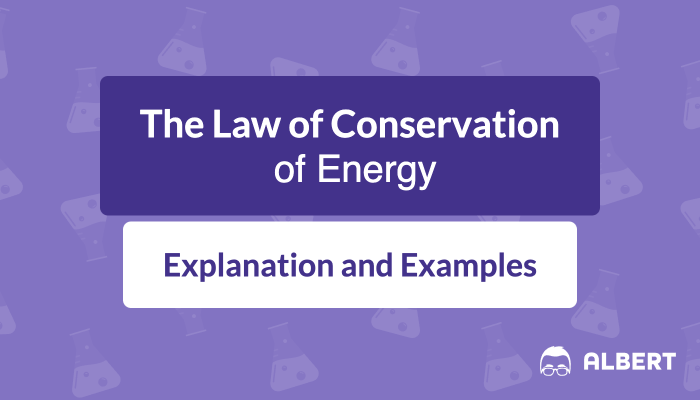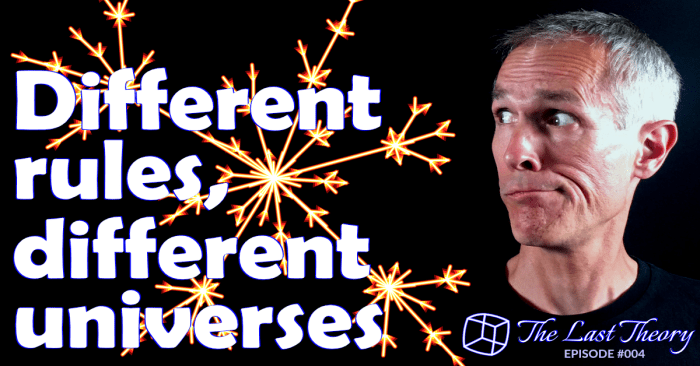
What is the difference between scientific theory and scientific law? These terms are often used interchangeably, but they have distinct meanings in the scientific community. Understanding the difference is crucial for appreciating the nature of scientific knowledge and how it advances over time.
Scientific theories and laws are both fundamental components of scientific understanding, representing the culmination of extensive research and rigorous testing. However, they differ in their scope, level of certainty, and role in scientific inquiry. Scientific theories aim to explain why things happen, while scientific laws describe how things happen.
Introduction
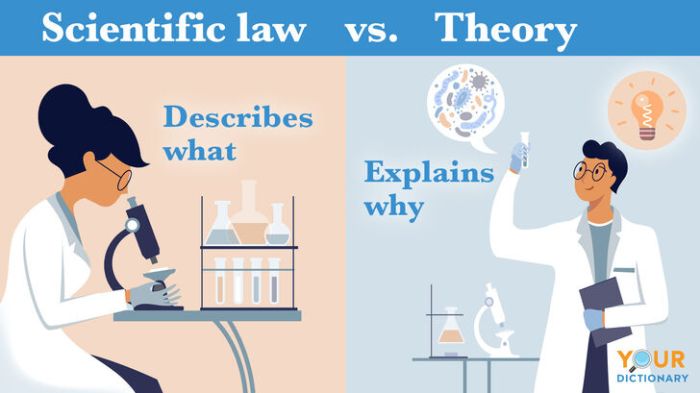
Scientific theories and laws are fundamental concepts in science, often used interchangeably but with distinct meanings. While both represent established scientific knowledge, they differ in their scope, purpose, and level of certainty.
This exploration will delve into the core distinctions between scientific theories and laws, examining their historical development and providing examples across various scientific disciplines.
Historical Context
Scientific theories and laws have evolved alongside the scientific method, reflecting the ever-evolving understanding of the natural world. The concept of a scientific law emerged during the Scientific Revolution, particularly in the 17th century, with the work of Isaac Newton and his laws of motion and gravity. These laws were initially viewed as absolute and universal, describing fundamental principles governing the physical world.
Scientific theories, on the other hand, developed more gradually. The term “theory” was initially used to describe speculative ideas, but it gained a more rigorous definition in the 19th and 20th centuries. The theory of evolution by natural selection, proposed by Charles Darwin in the 19th century, exemplifies this shift. Theories were no longer seen as mere speculations but as comprehensive explanations supported by substantial evidence and capable of generating testable predictions.
Examples of Scientific Theories and Laws
- Scientific Laws:
- Newton’s Law of Universal Gravitation: This law states that every particle in the universe attracts every other particle with a force that is proportional to the product of their masses and inversely proportional to the square of the distance between their centers. This law explains the force that keeps planets in orbit around the sun and governs the motion of objects on Earth.
- Law of Conservation of Energy: This law states that energy cannot be created or destroyed, only transformed from one form to another. This fundamental law governs all energy transformations in the universe, from the burning of fuel to the generation of electricity.
- Law of Conservation of Mass: This law states that the total mass of a closed system remains constant over time, regardless of changes within the system. This law is essential in understanding chemical reactions and other physical processes.
- Scientific Theories:
- Theory of Evolution by Natural Selection: This theory explains the diversity of life on Earth through the process of natural selection, where organisms with advantageous traits are more likely to survive and reproduce. This theory has been supported by a vast body of evidence, including fossils, DNA analysis, and observations of natural populations.
- Theory of Plate Tectonics: This theory explains the movement of Earth’s lithosphere, the rigid outer layer of the Earth, and the formation of continents, mountains, and oceans. This theory is supported by evidence from geological formations, paleomagnetism, and the distribution of earthquakes and volcanoes.
- Theory of Relativity: This theory, developed by Albert Einstein, explains the relationship between space, time, gravity, and the universe. It consists of two parts: special relativity, which deals with the relationship between space and time, and general relativity, which explains gravity as a curvature of spacetime.
Scientific Theory
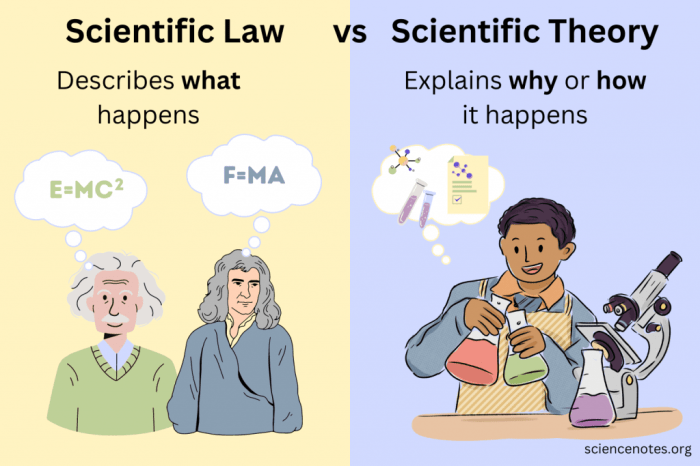
A scientific theory is a well-substantiated explanation of some aspect of the natural world that can incorporate facts, laws, inferences, and tested hypotheses. It is not simply a guess or an educated hunch. Instead, it is a comprehensive explanation that has been repeatedly tested and supported by evidence.
Nature of Scientific Theories
Scientific theories are not absolute truths, but rather the best current explanations based on available evidence. They are constantly being refined and updated as new information becomes available. A scientific theory can be modified or even replaced if new evidence contradicts it.
Developing a Scientific Theory
The development of a scientific theory is a long and complex process that involves several steps:
Observation and Data Collection
The process begins with careful observation of the natural world. Scientists collect data through experiments, surveys, and other methods. This data provides the foundation for developing a theory.
Formulating a Hypothesis
Based on the collected data, scientists formulate a hypothesis, which is a testable explanation for a phenomenon. A hypothesis is a proposed explanation for an observation, which can be tested by further investigation.
Testing the Hypothesis
Scientists test their hypotheses through experiments, which are carefully controlled procedures designed to isolate and test specific variables. The results of these experiments provide evidence that either supports or refutes the hypothesis.
Developing a Theory
If a hypothesis is repeatedly supported by evidence, it can be developed into a theory. A scientific theory is a well-substantiated explanation of some aspect of the natural world that can incorporate facts, laws, inferences, and tested hypotheses. It is not simply a guess or an educated hunch. Instead, it is a comprehensive explanation that has been repeatedly tested and supported by evidence.
Characteristics of a Strong Scientific Theory, What is the difference between scientific theory and scientific law
A strong scientific theory possesses several key characteristics:
- Power: A strong theory can explain a wide range of observations and phenomena. For example, the theory of plate tectonics explains a wide range of geological phenomena, such as earthquakes, volcanoes, and mountain formation.
- Predictive Power: A strong theory can make accurate predictions about future observations. For example, the theory of gravity can predict the trajectory of a projectile.
- Testability: A strong theory is testable, meaning that it can be tested through experiments and observations. For example, the theory of evolution can be tested by comparing the DNA of different species.
- Parsimony: A strong theory is parsimonious, meaning that it is the simplest explanation that can account for the observed phenomena. For example, the theory of relativity is a parsimonious explanation for the behavior of gravity and light.
- Consistency: A strong theory is consistent with other well-established scientific theories. For example, the theory of evolution is consistent with the theory of genetics.
Comparison of Scientific Theory and Law
| Characteristic | Scientific Theory | Scientific Law |
|---|---|---|
| Explanation | Provides a comprehensive explanation for a phenomenon. | Describes a pattern or relationship in nature. |
| Scope | Broad in scope, explaining a wide range of observations. | Narrow in scope, describing a specific pattern or relationship. |
| Evidence | Based on a large body of evidence, including observations, experiments, and inferences. | Based on repeated observations and experiments that consistently demonstrate a specific pattern. |
| Testability | Testable through experiments and observations. | Testable through experiments and observations. |
| Modification | Can be modified or replaced if new evidence contradicts it. | Generally considered to be unchanging, but can be refined with new data. |
| Example | Theory of evolution, theory of plate tectonics, theory of relativity. | Newton’s law of gravity, law of conservation of energy, law of conservation of momentum. |
Last Recap

The distinction between scientific theory and law is crucial for understanding the nature of scientific knowledge. Scientific theories provide explanations for observed phenomena, while scientific laws describe the relationships between observable quantities. Both theories and laws are essential tools for scientific understanding, guiding research and leading to new discoveries. As our understanding of the natural world deepens, scientific theories evolve and new laws are discovered, demonstrating the dynamic and ever-evolving nature of science.
Question Bank: What Is The Difference Between Scientific Theory And Scientific Law
Can a scientific theory become a scientific law?
While theories can provide the foundation for laws, they don’t automatically transform into laws. A theory explains why something happens, while a law describes how it happens. A theory might be refined or expanded upon, but it doesn’t become a law.
Are scientific theories just guesses?
No, scientific theories are not guesses. They are well-substantiated explanations supported by a vast body of evidence. Theories are constantly tested and refined, and they can be modified or even replaced if new evidence emerges.
What is the difference between a scientific law and a scientific principle?
The terms “scientific law” and “scientific principle” are often used interchangeably. However, a principle is often considered a more general statement that applies to a wider range of phenomena. A law, on the other hand, is typically more specific and describes a particular relationship between variables.
